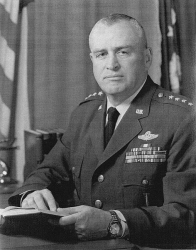
 |
|
|
||
|
William Hugh Blanchard 'Butch' |
||||
|
Graduate, U.S. Military Academy, Class of 1938 Engagements: • World War II (1941 - 1945) |
||||
| Biography: | ||||
|
William Hugh "Butch" Blanchard General, U.S. Air Force William Hugh "Butch" Blanchard was born on 6 February 1916 in Boston, MA. He received his high school education in Chelsea, MA, and graduated from Phillips Exeter Academy before entering the U.S. Military Academy in 1934. He graduated and received his commission as a Second Lieutenant in 1938. After completing pilot training at Randolph and Kelly Fields, TX, in 1939, he held assignments as a flight instructor and as Chief of Advanced Pilot Training in the Flying Training Command. In 1943 he was selected for duty with the initial B-29 bomber wing being formed in Salina, KS. As Deputy Commander of the 58th Bomb Wing, in 1944 Blanchard flew the first B-29 into China to begin his participation in strategic bombing operations against the Japanese mainland. Later, as Commander of the 40th Bomb Group (B-29) and then as Operations Officer of the 21st Bomber Command in the Marianas, he planned and flew low-level fire raids against major Japanese targets. In the final phase of World War II, Colonel Blanchard was directed to prepare and supervise the detailed operations order for the delivery of the first atomic bomb on Hiroshima. He was the backup pilot for the Hiroshima A-bomb drop, which was ultimately delivered by Colonel Paul W. Tibbets, Commanding Officer of the 509th Atomic Bombardment Group or Wing. After the war, on 20 January 1946, Blanchard became Commanding Officer of the 509th, succeeding Tibbets. By this time, post-war demobilization had reduced the 509th to a skeleton crew. But Blanchard and the 509th were immediately ordered to commence operations for the "Operation Crossroads" atomic tests at Bikini Atoll. With the highest priority, crews were amassed and in March the 509th was transferred to Kwajalein, Marshall Islands, for the Bikini atomic bomb tests that took place that July. At the conclusion of the Operation Crossroads' tests, on 23 August 1946 Colonel Blanchard assumed the duties of Commanding Officer of Roswell Army Air Field, NM (re-named Walker Air Force Base in 1948). Roswell became the permanent home of the 509th although it had again been reduced to minimal operations after the Crossroad tests. However, in September 1946, they received orders to remain at Roswell and train and equip a very heavy bomber air force with nuclear strike capability, which became fully operational in February 1947. On 8 July 1947, Colonel Blanchard issued an official Army Air Force press release stating that the base intelligence office had recovered a so-called "flying disc" or "flying saucer" from a nearby ranch. It had been found "sometime last week," and they were flying it to "higher headquarters." The press release and the media feeding frenzy that followed it triggered the so-called Roswell UFO Incident. Higher headquarters turned out to be Brigadier General Roger Ramey, head of the Eighth Army Air Force in Fort Worth, TX, who quickly pronounced it a misidentified weather balloon. Ironically, Blanchard's press release and the Roswell Incident it triggered are perhaps what Blanchard became best known for by the general public decades later when the event was re-opened and investigated, with many books written on the event. A year later, in 1948, Blanchard was assigned to Strategic Air Command's Eighth Air Force Headquarters in Fort Worth as Director of Operations. Blanchard helped direct the atomic training of crews for B-36s, the U.S.' first intercontinental bombers. After commanding B-50 and B-36 bomber units of SAC, he was assigned as Deputy Director of Operations for that command in 1953. In June 1956 he was a member of a group of U.S. Air Force officers who accompanied General Nathan Twining, then Chief of Staff of the U.S. Air Force, on an official visit to the Soviet Union. The visit included a conducted tour of points of military interest in the Moscow and Stalingrad areas. Blanchard assumed command of SAC's 7th Air Division in England in 1957. Upon his return to SAC Headquarters three years later, he was assigned as Director of Operations. After 15 years of continuous service in SAC, he was appointed as the Inspector General, U.S. Air Force, and was promoted to the rank of Lieutenant General. In August 1963 he was named Deputy Chief of Staff, Programs and Requirements, in Headquarters U.S. Air Force. He assumed duty as Deputy Chief of Staff, Plans and Operations, in February 1964. Later that year, he was assigned additional duty as the Senior Air Force member, Military Staff Committee of the United Nations. On 19 February 1965, Blanchard was promoted to the four-star rank of General and assigned as Vice Chief of Staff of the U.S. Air Force. He was still on active duty when he died on 31 May 1966. Medals and Awards Distinguished Service Medal Silver Star Medal Legion of Merit (3 Awards) Distinguished Flying Cross (2 Awards) Bronze Star Medal Air Medal (2 Awards) Presidential Unit Citation Asiatic-Pacific Campaign Medal with 6 Bronze Stars Missile Badge Command Pilot Wings Death and Burial William H. "Butch" Blanchard died on 31 May 1966 while actively serving as Vice Chief of Staff of the U.S. Air Force. He was 50 years old. He is buried at the U.S. Air Force Academy Cemetery in Colorado Springs, El Paso County, CO.
|
||||
| Honoree ID: 442 | Created by: MHOH | |||
Ribbons
Medals
Badges
Honoree Photos
 |  |  |
 |  |
 |


